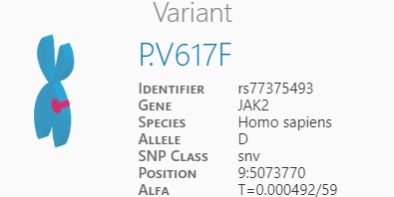The JAK2 V617F mutation is a specific genetic alteration found in various types of myeloproliferative neoplasms (MPNs), a group of blood cancers characterized by the overproduction of blood cells. This mutation occurs in the JAK2 gene, which encodes a protein that is part of the JAK-STAT signaling pathway, a critical pathway for the regulation of blood cell production.
The variant known as rs77375493, previously referred to by the older identifiers rs386626619 and rs121912471 (which have now been consolidated into rs77375493), is positioned at 9:5073770 in both the GRCh38 and GRCh37 human genome assemblies.
Prevalence in Different Types of MPNs
Polycythemia Vera (PV): The JAK2 V617F mutation is present in over 95% of patients with PV. This high prevalence makes the mutation a key diagnostic marker for PV. In PV, the mutation leads to the overproduction of red blood cells, but it can also affect white blood cells and platelets.
Essential Thrombocythemia (ET): Around 50-60% of patients with ET harbor the JAK2 V617F mutation. In ET, the mutation primarily results in the overproduction of platelets, leading to an increased risk of clotting disorders.
Primary Myelofibrosis (PMF): The mutation is found in approximately 50-60% of PMF cases. In PMF, the bone marrow becomes scarred (fibrotic), which can lead to anemia and an enlarged spleen. The JAK2 V617F mutation contributes to the pathogenesis of the disease by promoting the proliferation of marrow fibroblasts and altering the bone marrow environment.
The JAK2 V617F mutation is one of the most common genetic alterations across all MPN types, with its prevalence varying among the different disorders. It is a somatic mutation, meaning it is acquired during a person’s life and is not inherited. The mutation causes the JAK2 protein to be constitutively active, even in the absence of external signals that normally regulate blood cell production. This uncontrolled activation leads to the excessive growth and proliferation of blood cells seen in MPNs.
The detection of the JAK2 V617F mutation has significant clinical implications. It is not only crucial for the diagnosis and classification of MPNs but also has implications for prognosis and treatment decisions. For instance, patients with the JAK2 V617F mutation may respond differently to certain therapies, including JAK inhibitors, which specifically target the aberrant signaling pathway activated by the mutation.
In summary, the JAK2 V617F mutation plays a pivotal role in the pathogenesis of several MPNs, with a high prevalence in PV and significant frequencies in ET and PMF. Its detection is a key factor in the diagnosis, understanding, and management of these diseases.








